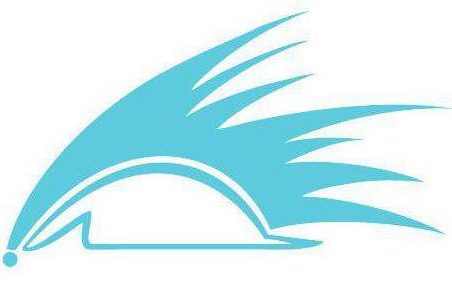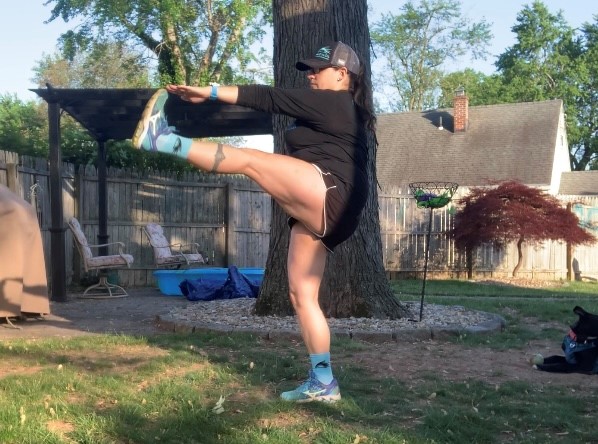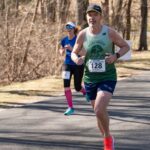This is the third and final part of a three part series on Run Efficiency, Common Run Injuries; and Run Injury Prevention. If you have questions about run form or run injury prevention please reach out to Coach Laura at [email protected].
You may have noticed a trend in the prevention of the injuries we reviewed in our previous post about common run injuries. Cue STRETCH!! Along with proper run form, being ready to run is crucial. Let me take you on a journey through some of my favorite ways to warm up and get your soft tissue ready for the stress of running.
Dynamic Warm ups:
Heel Walks
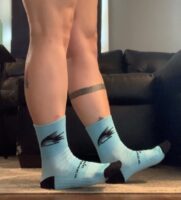
This exercise will help improve the functional range of motion and stability of the ankle, as well as, strengthen the muscles around the shin to reduce shin splints. Keeping the toes pointed up will help strengthen your tibialis anterior, the muscle around the front of your shin.
- Start with chest up & out and shoulders back.
- Raise both of your toes off the ground.
- Step forward with your right leg and drive your heel into the ground. Keep the toes pointed upwards at all times.
- Then step forward with your left leg
- Continue this process for a total of 20 yards.
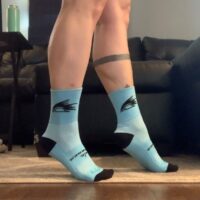
Toe Walks
This exercise will help strengthen your calf muscles and also increase the functional range of motion and stability of the ankle joint. Keeping your toes pointed down will activate and isolate your calf muscles.
- Start with chest up & out and shoulders back.
- Raise both of your heels off the ground, balancing on the balls of your feet.
- Step forward with your right leg, driving the ball of your foot into the ground. Toes should be pointed down.
- Continue this process for a total of 20 yards.

Knee Hugs
Knee hugs help improve the functional range of motion of the lower back and hip flexor muscles, as well as, enhance balance and postural control.
- Start with chest up & out and shoulders back.
- Lift your right knee and grab it with both hands pulling it high and close to your chest.
- At the same time, lift your left heel (plantarflexion/calf raise) keeping good posture.
- Hold the position for 2 – 3 seconds.
- Slowly let go of your right knee, take a step forward with the left leg and repeat this process.
- Continue this process for a total of 20 yards.
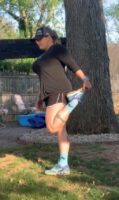
Quad Stretch
This exercise will focus on your quadriceps and hip flexor muscles to help improve balance and stability.
- Start with chest up & out and shoulders back.
- Bend your right knee and grab your ankle behind you with your right hand as you pull your heel into your gluteus muscle.
- At the same time, rise up onto the ball of your left foot.
- Hold the position for 2 – 3 seconds.
- Slowly let go of your right ankle, take a step forward with the left leg and repeat this process.
- Continue this process for a total of 20 yards.
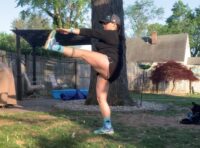
Straight Leg March
Straight leg marching will help develop lower back and hamstring flexibility. It’s important that you perform this exercise in slow, controlled motion. Your leg should only go up as high as it feels comfortable.
- Start with chest up & out and shoulders back.
- Hold both arms out in front of you and without bending your knee, kick with your right leg straight out in front of you foot flexed, trying to touch your fingertips to your fingers while maintaining proper posture and engaging your core.
- Lower your right leg. Once your right leg touches the floor, repeat on the left leg.
- Continue this process for a total of 20 yards.
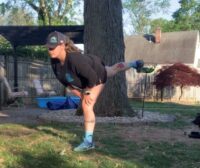
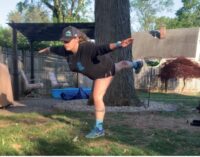
Inverted Hamstring Stretch
This exercise will help to improve the dynamic flexibility of your lower back and hamstrings, as well as, ankle stability and balance.
Research has shown that the lack of flexibility in the hips (hamstring, hip flexors, glutes muscles) can contribute to lower back pain. To help prevent back pain, it is important to improve your flexibility in the hamstrings.
- Start upright with chest up & out and shoulders back.
- Lift your right foot slightly off the floor behind you.
- Without changing the angle of your left knee, bend your hips and lower your torso as far as you can.
- As you bend over, lift up your arms straight out to your sides until they are in line with your torso.
- This takes some practice, you can start by supporting your hands on your planted leg and extend once you find your center balance
- Return back to the starting position and repeat with your left leg
- Repeat 3-5 times on each side
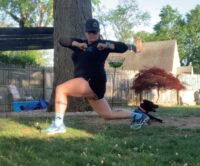
Rotational Lunge
These lunges help increase the range of motion in your obliques/abdominals and hip flexors. It also enhances strength in the quad, glutes, and core.
- Begin by standing with your feet shoulder-width apart.
- Step forward, taking an over-exaggerated step with your right leg to initiate the lunge.
- Keep your shoulders back, chest up & out, while bending the right knee 90 degrees.
- Do NOT allow your right knee to pass in front of your toes
- Your left knee should come about one to two inches from the floor in-line with the hip.
- Keep your core engaged and twist at your waist so that your left elbow moves towards your right knee.
- Rotate back to the center.
- Firmly plant the right foot into the ground and pull your body weight forward.
- As you bring yourself to an upright position and begin to center your weight over the right leg, bring the left leg off the ground and slowly swing it forward to initiate the next lunge.
- Continue this process for a total of 20 yards.
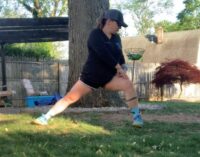
Lateral Lunge
Lateral lunges help develop the mobility of the hip, as well as, of motion in the groin, hamstrings, and glutes.
- Start with chest up & out and shoulders back and feet shoulder width apart.
- Take a medium size step with your right leg and keep your right foot facing forward.
- Slowly lower your hips in line with the right knee.
- Getting low, keep your hips back and holding this position for one to two seconds
- Bring your left foot under your body and repeat the movement on the left side.
- Repeat 3-5 times on each side
Ready, Set, RUN!!
